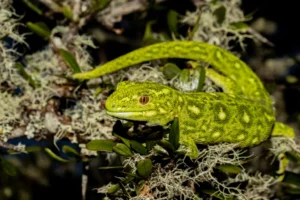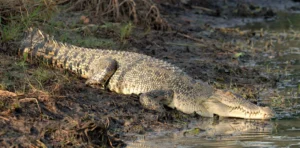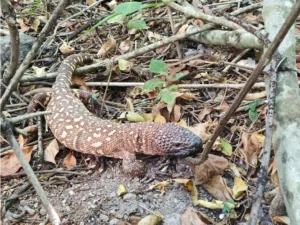If you’ve ever watched a lizard basking in the sun or darting up a wall, you might’ve wondered where they fit in the animal family tree.
They kind of look like little dragons, and sometimes people even mistake them for tiny dinosaurs. But how close are they really? Are lizards related to crocodiles?
Yes, lizards and crocodiles are distant relatives, but they belong to different branches of the reptile family tree. Both come from a big ancient group called reptiles, which includes snakes, turtles, and even birds. But while lizards belong to a group called Lepidosauria (with snakes), crocodiles belong to another group called Archosauria; the same one that gave rise to dinosaurs and birds.
That’s what makes this connection so interesting. Crocodiles are actually closer to birds than they are to lizards.
Still, if you go back far enough, they all share the same ancient reptile ancestors.
How Lizards And Crocodiles Split On The Reptile Family Tree
If you imagine the reptile family tree like a huge branching road map. Lizards and crocodiles took different turns a long time ago, about 250 million years back.
After early reptiles appeared, one main group became Lepidosaurs, which led to lizards and snakes. Another became Archosaurs, which led to crocodiles, dinosaurs, and birds.

So while both started from the same ancient reptile roots, their paths have been separate ever since. It’s like having the same great-great-great-great-grandparents but growing up in totally different worlds.
You can see this in how they look and live. Lizards are light, quick, and often climb trees or walls. Crocodiles are heavy, armored, and built for life in the water.
Both are reptiles, but evolution shaped them for very different jobs.
What Lizards And Crocodiles Still Have In Common
Even though they took different paths, lizards and crocodiles still share a few family traits that go way back in time.
They both:
-
Have scaly skin that helps stop water loss.
-
Lay eggs with tough shells.
-
Depend on external heat to warm their bodies.
-
Breathe air through lungs and have similar bones in their skulls.
If you look closely at a crocodile’s thick scales and then at the smoother scales of a gecko or iguana, you can still spot the same general idea: tough, dry skin made for life on land.
How Their Differences Tell The Story Of Evolution
The differences between lizards and crocodiles show how animals adapted to survive in very different environments.
Crocodiles became massive, semi-aquatic hunters. Their eyes and nostrils sit on top of their heads so they can hide under the water and watch without being seen.

Their powerful tails work like paddles. They’re basically living fossils, since their body plan hasn’t changed much in over 80 million years.
Lizards went the opposite way. They stayed small and flexible. Some, like geckos, developed sticky toe pads to climb smooth walls.
Others, like horned lizards, evolved ways to squirt blood from their eyes to scare predators.
They spread almost everywhere on land, from deserts to rainforests.
Both show different answers to the same ancient problem: how to survive as a reptile in a changing world.
Are Lizards And Crocodiles Related To Dinosaurs Too?
This is where it gets even more interesting. Crocodiles are actually part of the dinosaur side of the family tree.
They share a lot of features with dinosaurs, like the way their skull bones fit together and how they build nests and guard their eggs.
Lizards belong to the other side. They aren’t dinosaurs and aren’t directly related to them, even though they existed at the same time.
While dinosaurs ruled the land, lizards scurried around their feet, surviving in the shadows.
When dinosaurs went extinct, lizards kept going. Crocodiles did too, though barely. They both made it through that massive extinction about 66 million years ago.
One survived by being small and adaptable, the other by sticking to water and waiting it out.
How Crocodiles Ended Up Closer To Birds Than Lizards
It might sound strange, but crocodiles are genetically closer to birds than to lizards. Birds evolved from small, feathered dinosaurs, and those dinosaurs were archosaurs, just like crocodiles.
That means a crocodile has more in common with a chicken or an eagle than with a gecko or chameleon. Hard to believe, right? But when scientists compare DNA and bone structures, that’s what they find.

You can even see some shared traits. Crocodiles and birds both:
-
Have four-chambered hearts. Most reptiles only have three.
-
Build nests and watch over their eggs.
-
Communicate with sounds, like grunts, hisses, or calls to their babies.
So next time you see a crocodile floating in a swamp, think of it as a very distant, scaly cousin of the sparrow sitting on a nearby branch.
What Makes Lizards So Different From Crocodiles
Even though they share reptile roots, lizards have taken a very different path. Here’s how they stand apart:
-
Size and speed: Lizards range from tiny geckos a few inches long to large monitors several feet long, while crocodiles can reach over 20 feet.
-
Lifestyle: Lizards mostly live on land or in trees, while crocodiles are semi-aquatic.
-
Body shape: Lizards have flexible bodies and movable eyelids; crocodiles have heavy armor and fixed eyelids.
-
Diet: Lizards eat insects, fruit, or small animals depending on the species, while crocodiles are strict meat-eaters.
Even their brains and senses work differently. Crocodiles rely on hearing and vibrations to find prey underwater
. Lizards use their eyes and tongues to explore, especially species like chameleons that can move their eyes independently.
How Fossils Connect The Two Groups
Scientists have found fossils that show how reptiles split and changed over millions of years.
Early reptile fossils from around 300 million years ago show traits that both lizards and crocodiles share, like similar skull shapes and bone structures.
As time went on, new fossils show how two clear lines formed. One led to lizards, snakes, and tuataras. The other led to crocodiles, pterosaurs, dinosaurs, and eventually birds.
Crocodiles basically froze in time, keeping many of their ancient features. Lizards kept evolving, giving rise to thousands of species with every shape and color you can imagine.
What This Means For Modern Reptiles
Understanding how lizards and crocodiles are related helps explain why reptiles are still so successful today. They’ve been through extinctions, climate changes, and competition from mammals, and they’re still here.

Crocodiles survived by sticking to water. Lizards thrived by staying small and adaptable. Between them, they show two very different survival strategies that both work.
It’s also a reminder that “reptile” doesn’t mean one single kind of animal. It’s a huge group full of ancient cousins that all found their own ways to live.
So, Are Lizards And Crocodiles Close Relatives?
Not really. They share a very old ancestor, but their connection is distant. Lizards belong to the lepidosaur side of the reptile family tree, while crocodiles belong to the archosaur side, along with dinosaurs and birds.
They’re more like long-lost cousins than close siblings. But they’re still tied together by scaly skin, egg-laying habits, and cold-blooded bodies, all traits passed down from those early reptiles that crawled across the Earth long before humans existed.
Conclusion
Lizards and crocodiles might look like they come from the same mold, but their family lines split hundreds of millions of years ago.
Lizards went one way and became quick, adaptable creatures that live almost everywhere. Crocodiles went another way and became powerful, ancient hunters that hardly changed at all.
So while they both belong to the big reptile family, crocodiles are actually closer to dinosaurs and birds than they are to lizards.
Every scaly face you see carries a piece of deep history, connecting the past to the present in ways you wouldn’t expect.
Hi, my name is Ezra Mushala, i have been interested animals all my life. I am the main author and editor here at snakeinformer.com.

